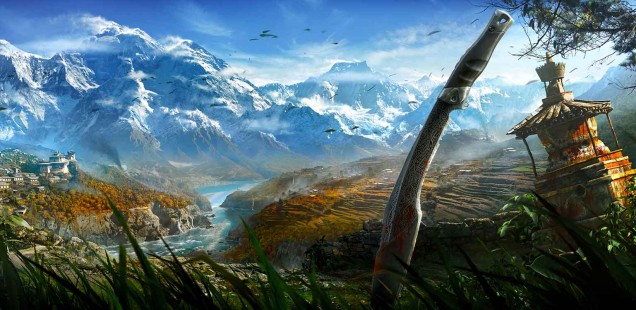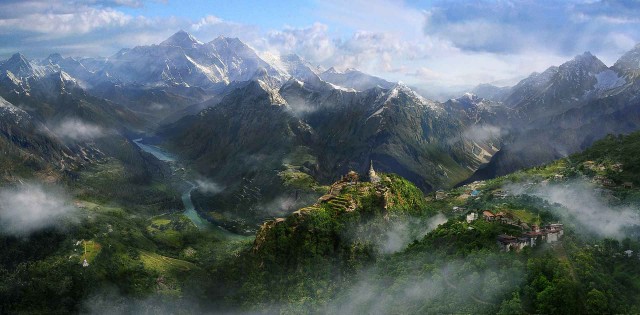
Due Diligence: Far Cry 4 Doesn’t Scare Me Any More
Leigh Harrison gives Far Cry 4 its Due
Horror film franchises are fascinating for many reasons, but one of their most intriguing traits is how ardently sequels follow the lead of their progenitor for inspiration. We could go whole-hog down the road discussing the artlessness of these economically-minded heirs, but I really like horror films, especially long running series of them, so I won’t hear of it.
There are ten and a half original Friday the 13th films. All of them, at least partially, take place around the setting of the original film, Crystal Lake, and all but one of them feature Jason Voorhees as the main antagonist/murderer man. The Halloween films all, apart from III, star Michael Myers as their bloke with a blade, and most of them insist upon visiting his old house at some point. While its appearance changes with almost every trip, we always know we’re there because Donald Pleasence shouts helpfully: “I knew you’d come home, Michaaaeeel!”.
Beyond this, though, there are the more subtle recurring themes and motifs. A Nightmare on Elm Street has the paranoia and mistrust of authority inherent in coming of age; Hellraiser the dangers of gluttony, sadism and pride; The Grudge and The Ring betrayal, respect and forgiveness; and Saw the pitfalls – both within and without the texts themselves – of uncontrollable money making. These reappearing elements foster a sense of continuity in intent so that while creators and performers may change with every entry, the disparate works seem more deliberate. But they also become expected and wholly defining traits, leading to the sort of contrivances that ensure 1428 Elm Street is visited at least once in every story told about Freddy Krueger.
The Hellraiser series is fascinating in this respect, because half of its films began life as wholly unrelated spec scripts bought on the cheap by Dimension Films and then injected, sometimes very awkwardly, with light doses of the supernatural horror the earlier films are known for. These later sequels are pretty much just Lifetime movies; overwrought melodramas that happen to have five or ten minutes where demons show up and teach characters a lesson by ripping them to pieces with lots of chains and hooks. Despite this cobbled together nature, lead actor Doug Bradley only decided to bow out at the ninth installment, determining then that the series was finally artistically bankrupt. The decidedly video gamey titled Hellraiser: Revelations was never going to be received very well; without Bradley it was doomed to lepur status by the series’ few remaining fans. Expectations can be very harmful if ignored by the creators of iterative art, such is the fervour surrounding them being continuously upheld. To get to the point where audiences blindly applaud such thematic and stylistic conventions, these things must first be repeatedly hammered into texts for their consumers. So, by this logic, the initial reproduction of such elements – the first step down the road to them becoming bona fide tropes in the first place – is equally, if not more dangerous to artistic identity and the way audiences understand and interact with a work.
***
Stepping into Far Cry 4 my initial thoughts were “Christ, that monkey looks good,” followed shortly by “this Pagan Min character is dangerous and charismatic, Ubisoft has done it again!” For context’s sake, Far Cry 4 is an open world game about shooting things and the freedom to do so in a largely player-driven way. Just like the third entry in the series, you play as an American, here he’s Ajay Gale, who finds his way into a fractious country, the visually stunning Himalayan nation of Kyrat (fantastic looking monkeys), and becomes embroiled in an armed struggle against an oppressive regime. The head of this order is Min, a besuited despot not too dissimilar to 3‘s Vaas Montenegro, though this time out your chief antagonist is a dictator rather than a pirate. From their deliberately deep-yet-deranged verbosity it’s easy to draw instant parallels between the two. Both men also have a penchant for playing fast and loose with what others might deem the inescapable respect for human life. They are both clearly very dangerous men. Though much like the characters Tyler Durden or Dorian Gray, one also can’t help being slightly drawn to them, such is their calculating aptitude at turning on the charm. They also, like all truly compelling bad guys, display a great deal of respect for their counterpart. This makes both Vaas and Min considerably more frightening: both understand they may eventually fall to the player, yet still choose to continue down the road towards it regardless. I’m not going to be wholly reductive and say that they are identical because they really aren’t, but it is clear that the developers of 4 acutely appreciate why Vaas was compelling for so many and have understandably chosen to make Min a similar type of nemesis.
Once the opening salvo of character introductions are out of the way, you are let loose on Kyrat proper, essentially free to go about your business as you see fit. What to do though, when you’ve got a whole country to explore? Well, given that Far Cry 4 is pretty much Far Cry 3 Part II, I knew exactly what to do. I’m not pointing this out to lambast 4 for being lazy – criticism-peddling isn’t my bag as there’s usually something more interesting to say if you try hard enough to find it – but it’s worth pointing out to contextualise the rest of this.
Character progression is a good and cheap way of getting the player to do a lot of things they would otherwise balk at. Embodying a weak character and being able to improve and add to their skills taps right into our brain’s reward centers, while also creating a narrative all unto itself. Ubisoft has known this for a long time, and has spent the last decade perfecting the gentle progression of abilities into an art form. In both of the Far Crys I’m discussing here, your protagonist begins their journey much like a babe in the woods: they are physically unimposing, unable to withstand or perpetrate much violence; they are lacking in basic knowledge of flora and fauna; they are not well versed in automobile mechanics; their animal skin wallet is shamefully small. You’re given missions to begin undermining Min’s considerable power base right from the start, but instead of pursuing any of these, I decided to address some of Ajay’s character deficiencies first.
Guns, in a game all about the shooting of them, are invaluable, as is the ammunition you fire into the heads of your enemies and the explosives you throw in their general direction. The initial problem here, is that Ajay, an American tourist, isn’t clothed in the sort of militia garments that hold a dozen or more Molotov cocktails. Kyrat, however, is full of animals that, once skinned, make really good repositories for all kinds of weaponized doodads. It was because of my prior knowledge from 3 – the system of upgrading ammunition and weapon capacity through tanned hides is the same in both – that I spent my first few hours in the Himalayas not taking on The Man, but stalking the local wildlife and crafting increasingly elaborate papuses. This was unquestionably time well spent, as when I finally did go into battle – against man and not beast – I was more than equipped to offset my dodgy aim with significantly more bullets than I had any right to carry at such an early stage. The game fully allows – if not wholeheartedly encourages – this grand detour, as all the animals you need for the first handful of upgrades are helpfully found dotted around the early districts of the map. I’m not convinced, though, that without having played the previous entry, I’d’ve jumped so fully into the hunting fray. In 3 the system was entirely new to me, so I approached it with trepidation, only seeking out suitable prey if I happened to be in an area they were found in abundance. It took me most of the game to craft the biggest bag and the largest explosives belt, not because doing so was difficult, but because I was more intent on forging ahead with the story and its campaign missions. Coming into 4 with all the knowledge of 3, I approached everything differently. I understood that a couple of hours of toil at the beginning would set me up for the rest of the game and make me a more formidable adversary. I actively shunned my narrative responsibilities in favor of mechanical advancement, only knowing to do so because of my prior experiences with something wholly different, yet in the same breath exactly the same.
This pattern of investing all my time in groundwork rather than the narrative meat of the game continued as my activities spread out across the country. I dashed from one of Min’s propaganda-broadcasting towers to another, climbing them all in quick succession to reveal important information on my map and unlock more powerful weapons. Once this was done, and I finally had access to a silenced sniper rifle, I went through all the hostile outposts in much the same fashion; systematically depopulating them as I cut a swathe across Kyrat and opened up fast travel points at each one. My wallet, despite now being upgraded and adorned with bharal, macaque and rhino flesh, was getting perilously full from all the plunder I’d looted from enemy corpses. I went on a spending spree out of necessity rather than choice, buying up treasure maps which now showed me the location of every single cache of valuables, point of interest and hidden collectible. My map soon resembled something you’d receive from a small town’s tourist information bureau on a camping weekend to the Peak District: all covered in little pips denoting the most mundane of attractions; here was the artisanal cheese producer, the ethically-minded stationer and the curious bar that only sells temperance herbal tonics. The whole thing would have been thoroughly intimidating if I hadn’t already known what to look for and what to selectively ignore, as I began to fully appreciate that what I’d learnt from 3 could be transplanted wholesale into 4. At this point I’ve still only tackled a handful of the game’s core story missions, as I know that there is still so much groundwork to be lain before I can approach them with good conscience.
The entire appeal – or at least raison d’etre – of the open world game is that they provide players with lots of options, options which are, in my view, so multiplicitous that they obscure their own hollow nature. Being asked to eliminate a target silently or with a specific weapon still boils down to ending a life. Blowing up a truck or blowing up three Jeeps in convoy is wanton destruction however you dress it up. The magic of the open world game lies in its unwavering enthusiasm to pull off the con of variety. There are two dozen towers to climb in Far Cry 4. Thirty outposts to conquer. Sixty guns to acquire. Forty-odd skills to unlock. Everything you do is a point on a graph of progression; your every action being gratified with a small statistical reward. However, these accolades only truly function properly as distractions and incentives if their inner-workings are a mystery to the player. In understanding how everything fits together, I’m suddenly able to rationalize and order the bubbling chaos the game would otherwise use to keep me off balance and in awe of its disingenuous variety. This, in turn, leads to me interacting with the game not as if it were one sprawling, open-ended tangle of stuff, but in effect as a series of clearly laid out, linear sequences; one batch of tasks leading neatly onto the next with a logical path running right through them all.
The danger, then, is that in knowing the most efficient way to progress through the game, I’m bound to a hard slog of the same sort of activity for hours at a time. The alternative would be to mindlessly dash from one thing to another just for the sake of variety, even though I know I’m wasting my time in the long run, which, let’s all agree, would just be silly. At this point continuing to play Far Cry 4 is not so different to watching, say, Friday the 13th Part VIII: Jason Takes Manhattan: neither has the ability to surprise me because I’m so intimately educated in how they work. I can watch a horror film and call the scares before they happen, single out the eventual survivor in the opening scenes and successfully tell whether what is about to jump out of that wardrobe is the bad guy or just a cat. I still watch them, but from a different perspective and with different goals, and I think my experience of Far Cry 4 going forward is going to be very similar. There’s no sense of wonder or excitement or intrigue surrounding what I’m doing, but at the same time, there also isn’t the frustration, disappointment and resignation I often feel concerning the banality of open world games belied by their promise of unadulterated exploration. I suppose, if anything, being able to enjoy my experience even while recognizing it is fully devoid of surprises must say something positive about the flexibility of the open world design ideal. That the freedom to run around – even in such a self-regulated and procedural way as I am – must be compelling in its own right. Or perhaps the hold of Ubisoft’s progression model is just so tight that, as long as little bars fill up and numbers keep getting bigger, I’ll do anything to keep the dopamine flowing.
Leigh Harrison lives in London, makes DVDs for a living and owns a hamster. He likes canals and rivers a great deal, and spends a lot of his time walking. He occasionally says things about videogames on the Internet, and other things on The Twitter.



